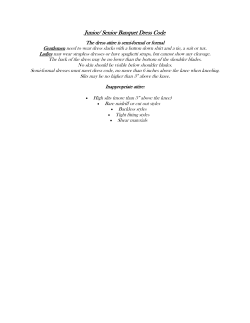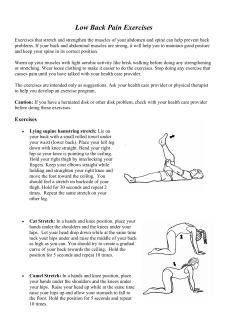
"Looking through the Lens of Science at the KNEE" (Another
23_yang:07 19/06/08 10:26 By Holly Sweeney-Hillman, Center Director, Montclair, NJ Page 10 KNEE Looking through the Lens of Science at the Another in our series of essays about the Biomechanics of Tai Chi Chuan A The knee is the largest and perhaps most complex joint in the human skeleton. Although we refer to it as “the knee”, as if it were a single joint, it is actually comprised of two joints (the 10 | SIDE VIEW OF THE KNEE Patellofemoral joint > < Femur > Tibiofemoral joint > Fibula > N u m b e r 2 3 | S p r i n g & S u m m e r 2 0 0 8 © w w w. y a n g f a m i l y t a i c h i . c o m figure 1 ( T te cov he nd er p on ed ate ) by lla ll Tai Chi students and teachers have great interest in the topic of the knee. Students know that protecting their knees from injury while practicing is essential and instructors understand the importance of helping students develop good habits of using their knees. The goal of this article is to give all Tai Chi players an understanding of their knee joints and some tips on how to align, stabilize, and strengthen their knees more effectively. < Tibia tibiofemoral joint and the patellofemoral joint) which coordinate the movements of four bones (the femur, the tibia, the patella, and the fibula). Figure 1 The basic movement of the knee joint is moving forward into flexion, what is usually called “bending” and moving vertically into extension, which is generally called “straightening”. If you look at a person going upstairs, one leg is in extension and one leg is in flexion. Figure 2 Even though the joint appears to be moving in only one direction at any given time, the actual movement in the joint is occurring in three planes simultaneously, hence the complexity of this 23_yang:07 19/06/08 10:26 Page 11 figure 4 THE TIBIOFEMORAL JOINT Of the two joints that comprise the knee, the tibiofemoral joint is the larger and more complex. Figure 3 shows this joint in a bent position. Sometimes this joint is referred to as a “hinge joint” but this is a misleading description. The primary movements of the tibiofemoral joint are rolling and gliding but there is also a spiral aspect to its movement which will be explained in a moment. Figure 4 diagrams the rolling, gliding movement of the femur over the tibia. You can get a feeling for this movement by holding one palm outstretched to represent the flattened top of the tibia (shin bone of the lower leg) and making a fist with your other hand figure 3 hardworking joint. However, at any one moment during movement of the knee, the action of one muscle group will clearly dominate, making it an easy joint to understand from the viewpoint of muscle action. figure 5B figure 2 figure 5 SIDEVIEW - Diagram of the movement of the Tibiofemoral joint to represent the rounded end of the femur (thigh bone). Resting “the face” of your fist on top of your palm, slowly bring down your elbow so that your fist rolls against your palm until the face of your fist points forward. This movement simulates the rolling, gliding movement of the thigh bone resting on top of the tibia as it moves from extension (straightened knee), Figure 5a, to flexion (bent knee), Figure 5b. There is another movement that happens in this joint of which you may be unaware involving a bone that you may not have thought about very much. However, knowledge of this movement and the bones involved can help you align your knee with more precision and stability as you move from straight leg to bent leg postures. The movement is called “the screw-home mechanism” of the tibiofemoral joint. The little bone to the outside of the tibia in your lower leg, your fibula, assists with this movement. The purpose of the “screw-home” movement of the tibia and the fibula is to give more stability to the knee joint in any position of the knee because it utilizes muscle energy to stabilize the knee joint from side to side as it is moving. Muscle involvement always decreases strain on the ligaments which guide and stabilize the movement of any joint. In the case of the knee, a joint which experiences extremely high loads during movement (two to four times your total body weight in activities like going up and down stairs), muscle involvement to stabilize the joint is critical in preventing injury to the joint. N u m b e r 2 3 | S p r i n g & S u m m e r 2 0 0 8 © w w w. y a n g f a m i l y t a i c h i . c o m | 11 23_yang:07 19/06/08 10:26 Page 12 Looking through the Lens of Science at the Knee other as the fibula rotates outward toward the little toe side of your foot and the tibia rotates inward towards your big toe. This rotation in opposing directions stretches the interosseous membrane which connects the two bones of your lower leg deep within the flesh of your lower leg. The “Screw-Home” mechanism of the Tibiofemoral Joint (Adapted from Nordin, Frankel, 1989) Figure 6 illustrates the kinematics of the “screw home” mechanism. Simply stated, when you go from a flexed knee (for instance, when you are sitting in a chair) to a straightened knee (standing up), your tibia rotates towards your fibula and your fibula rotates toward your tibia. In other words, they rotate toward one another as you stand up. If you were to sit back down, they would rotate away from each other: the fibula rotating outwardly and the tibia rotating inwardly as your knee bent. You can probably feel the rotating movement of the fibula if you place your fingertips on the top of the fibula when you are seated, Figure 7a, and keep them there with a little pressure against the fibula as you straighten your legs, Figure 7b. As your knee bends forward, the outward rotation of the fibula helps keep your knee from falling inward because it opposes the inward rotation of the tibia. To correct the problem of your knee bending inward too much during flexion, your mind intent needs to stay with the fibula to make sure you allow it a root so that it can rotate outwards as you bend your knee. As you bend your knee forward, keep your fibula lined up with your little toe. The metatarsal joint of the little toe serves to root the fibula. With a firm root, the fibula can effectively balance the inward rotation of the tibia and keep the knee from falling inwards as the leg bends. In Figure 8, you can see the alignment of the top of the fibula, where the man’s finger is pointing, directly over the little toe side of his foot. If you practice this technique of aligning the fibula over the little toe side of your foot as your knee is bending forward, it will feel like your lower leg just below the tibiofemoral joint stretches open a little as your knee is bending. Indeed, the bones of your lower leg are opening away from each figure 7A 12 | N u m b e r 2 3 | S p r i n g & S u m m e r 2 0 0 8 © w w w. y a n g f a m i l y t a i c h i . c o m figure 7B THE PATELLOFEMORAL JOINT In flexion or extension, the patella (kneecap) slides back and forth along a groove in the femur (thigh bone). Figure 9 shows the patellar tendon pulled back to expose the grooved path on the surface of the femur on which the patella travels up and down during extension and flexion. You can also see how the patella is attached to the inner surface of the patellar tendon. The purpose of this joint is to give greater leverage and power to the quadriceps muscles which attach into the patellar tendon. The patellofemoral joint increases the efficiency of the quadriceps muscles by about 30%. Without this joint, it would be nearly impossible for the quadriceps muscles to generate enough force to do simple activities such as step up onto a stair. You can experience the independence of the patellofemoral joint by placing one hand over your kneecap when your knee is in a bent position and placing the fingers of your other hand in the crease which marks the location of the tibiofemoral joint, Figure 10. If you straighten your knee, figure 8 23_yang:07 19/06/08 10:26 Page 13 you can feel the kneecap pulled upwards by your quadriceps muscles. You will feel the distance between the two joints increase as you stand up if you keep one hand touching the kneecap and the other hand touching the back of the knee at the level of the tibiofemoral joint. MUSCLE DYNAMICS OF THE KNEE As stated earlier in this article, muscle dynamics of the knee are fairly explicit. The hamstring muscles in the back of the thigh and the quadriceps muscles on the front of the thigh move and stabilize the position of the knee as it goes from extension to flexion and vice versa. The action of the quadriceps brings the knee from a flexed to an extended position, the action of the hamstrings brings the knee from an extended to a flexed position. In other words, when you stand up from a seated position, it is the power of the quadriceps that makes this movement possible. When you go from a standing to a seated position, the hamstrings are the prime movers. When you practice Tai Chi, you work for extended periods of time in bent leg, or flexed, leg positions. This requires a lot of strength in the hamstring muscles. FRONT VIEW OF THE KNEE figure 9 Femur > figure 11B figure 11A A common mistake beginning Tai Chi students will make is to “stand up” as they move their weight from one leg to another. Doing exercises that strengthen their hamstring muscles will help them stabilize their knees so that they can move from one leg to another without changing level. Figure 11 illustrates an effective and safe hamstrings conditioning exercise which is also good for developing core strength. Begin with your feet resting on a physio ball with your legs outstretched and your hips lifted off the floor, Figure 11a. Keep your hips from sagging down and draw your heels towards your hips, flexing your knees, Figure 11b. Then, slowly extend your legs to allow the ball to roll away from you, keeping your hips off the floor as your legs slowly straighten. Allow your hips to rest on the floor before you start again. Repeat four more times and gradually increase the number of repetitions as your hamstrings get stronger. Sources for this article: Basic Biomechanics of the Musculoskeletal System, 2nd edition Nordin and Frankel, pgs. 115 – 133. Atlas of Skeletal Muscles, 2nd edition, Stone and Stone figure 10 Patella > < Femoral Groove Patella Tendon > Fibula > < Tibia N u m b e r 2 3 | S p r i n g & S u m m e r 2 0 0 8 © w w w. y a n g f a m i l y t a i c h i . c o m | 13
© Copyright 2025









